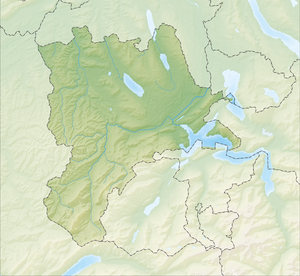Mühlenplatz power plant
| Mühlenplatz power plant | |||
|---|---|---|---|
| location | |||
|
|
|||
| Coordinates | 665 649 / 211542 | ||
| country | Switzerland | ||
| Waters | Reuss | ||
| Data | |||
| Type | Canal power plant | ||
| Primary energy | Hydropower | ||
| power | 0.9 MW | ||
| owner | Energie Wasser Luzern EWL | ||
| Start of operations | 1888 | ||
| turbine | Kaplan turbine | ||
| Website | Mühlenplatz power plant | ||
The Mühlenplatz power plant is a run-of-river power plant near the Spreuer Bridge on the Reuss in Lucerne in the canton of Lucerne . It belongs to the municipal works EWL Energie Wasser Luzern Holding .
history
Lucerne, along with Geneva , Thun and Zurich, is one of the Swiss cities with a lake drain. They were able to use hydropower as early as the Middle Ages thanks to the relatively low water level differences. The water-powered Lucerne Reuss mills were located within the city fortifications and were first mentioned in 1178.
In 1888/89 the city of Lucerne built a commercial building with a power plant for three Jonval turbines from Bell & Cie. In place of the mills directly on the Spreuer Bridge . Kriens built. This was rented to small businesses. The mechanical water power was transmitted from the power station to the commercial building by means of wave transmission. The four-story view Bachsteinhaus was destroyed by a fire in 1932.
The hydroelectric power plant with the Jonval turbines and the main transmission shaft was built in 1926 with a generator from Brown, Boveri & Cie. supplemented and had to supply electricity instead of mechanical energy for the factory for the public electricity supply of the city of Lucerne. The three-phase generator supplied three-phase current with a voltage of 380 V and for the supply of the tram with a voltage of 550 V to the city. The installed power was approx. 59 kW (80 PS ). The power plant had to be shut down in 1977 due to damage. As a result, the hydropower at this barrage remained unused for 20 years.
From 1996 to 1998, a new power station with two standard bevel gear tubular turbines from Sulzer Hydro was built at the old location . The small power station building from 1926 was demolished.
A complete machine unit of the old power plant with impeller, guide device, deflection gear, main shaft and head gear, including generator and control panel, have been preserved at the old location as a museum.
In 2015 the vertical bevel gear turbine 2600 of the Mühlenplatz power plant was overhauled by the Grimsel Hydro and flood protection flanks were installed so that the power plant would not be flooded in the event of a flood.
Needle weir in Lucerne
The needle weir regulates the outflow of Lake Lucerne and feeds the power plant, in which the longitudinal weir and the front weir direct the water to the canal and create the useful gradient.
The Lucerne needle weir is one of the few that has been preserved in its historical condition. While the weirs in all large rivers have been replaced by semi-automatic or fully automatic mechanical weir systems, the Lucerne needle weir is still being adjusted to the water level with extensive physical work. In the event of large amounts of water caused by thunderstorms, the opening of the weir must be enlarged by four to five men with the hook-shaped “zappis” by pulling out some of the 3.5 meter long “needles”.
Initially, the lake was dammed as a fixed threshold and longitudinal weir for the Lucerne Reussmühlen, which led to flooding in lakeside communities during high water. In 1608 the agenda had to mediate between the original Swiss cantons because of the backlog.
In the 18th century, the fixed weir was partially replaced with insertable wooden planks (needles) to enable better regulation of the lake during floods. In the dry season, too much water flowed off because of the needles, which led to problems with the water level being too low after the introduction of steamboat traffic.
For better regulation of the lake, the bed of the Reuss in the old town was lowered by 80 centimeters between 1858 and 1859 and the needle weir was rebuilt better sealed. The forehead weir for sea regulation has since had 175 needles.
Today's production
The two Sulzer Kaplan turbines have a runner diameter of 2.6 m and an installed power of 900 kW. With a maximum gross gradient of 1.8 m and a water volume of 58 m 3 / s, they generate around 3 GWh of electrical energy per year, which corresponds to an average output of around 350 kW. The small hydropower plant supplies around 1,000 households with green electricity. In April 2012 it was certified with the “Naturemade Star” quality label.
The Mühlenplatz power plant can be visited on certain days.
See also
literature
- W. Wyssling: The development of the Swiss electricity works and their components . Swiss Electrotechnical Association , 1946.
Web links
Individual evidence
- ↑ Swiss Society for the History of Technology and Industrial Culture (SGTI): In-Ku 18 Kraftwerk Mühlenplatz Luzern LU [1]
- ↑ Grimsel Hydro: KW Mühlenplatz
- ↑ EWL Luzern: Mühlenplatz small hydropower plant - ecology in the middle of the city of Lucerne
- ^ EWL Luzern: Visits


